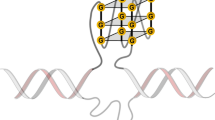Abstract
In the last decade, DNA duplex and G-quadruplex motifs have been investigated for their potential applications in nanotechnology. Recently, G-quadruplex–duplex hybrids, generated from the juxtaposition of these two structural elements, have been considered as DNA nanostructures for nanotechnological applications to take advantage of both duplex and G-quadruplex peculiarities. The junction between the two structural motifs can play an important role both for the structure and stability of these hybrids. Here, we analyze the thermodynamics of a number of G-quadruplex–duplex hybrids differing in the bases composition in proximity of the junction. Differential scanning calorimetry, circular dichroism, and gel electrophoresis methodologies were employed to highlight differences in their stability.






Similar content being viewed by others
References
Feldkamp U, Niemeyer CM. Rational design of DNA nanoarchitectures. Angew Chem Int Ed Engl. 2006;45(12):1856–76.
Simmel FC, Dittmer WU. DNA nanodevices. Small. 2005;1(3):284–99.
Lin C, Liu Y, Rinker S, Yan H. DNA tile based self-assembly: building complex nanoarchitectures. ChemPhysChem. 2006;7(8):1641–7.
Yatsunyk LA, Mendoza O, Mergny JL. “Nano-oddities”: unusual nucleic acid assemblies for DNA-based nanostructures and nanodevices. Acc Chem Res. 2014;47(6):1836–44.
Alberti P, Bourdoncle A, Saccà B, Lacroix L, Mergny JL. DNA nanomachines and nanostructures involving quadruplexes. Org Biomol Chem. 2006;4(18):3383–91.
Fotticchia I, Giancola C, Petraccone L. G-quadruplex unfolding in higher-order DNA structures. Chem Commun (Camb). 2013;49(82):9488–90.
Dutta K, Fujimoto T, Inoue M, Miyoshi D, Sugimoto N. Development of new functional nanostructures consisting of both DNA duplex and quadruplex. Chem Commun (Camb). 2010;46(41):7772–4.
Lim KW, Phan AT. Structural basis of DNA quadruplex–duplex junction formation. Angew Chem Int Ed Engl. 2013;52(33):8566–9.
Lim KW, Khong ZJ, Phan AT. Thermal stability of DNA quadruplex–duplex hybrids. Biochemistry. 2014;53(1):247–57.
Pagano B, Randazzo A, Fotticchia I, Novellino E, Petraccone L, Giancola C. Differential scanning calorimetry to investigate G-quadruplexes structural stability. Methods. 2013;64(1):43–51.
Giancola C. A convenient tool for studying the stability of proteins and nucleic acids: differential scanning calorimetry. J Therm Anal Calorim. 2008;91(1):79–85.
Giancola C. Thermodynamics of G-quadruplexes. In: Spindler L, Fritzsche W, editors. Guanine quartets: structure and application. Cambridge: Royal Society of Chemistry; 2013. p. 63–72.
Cantor CR, Warshaw MM, Shapiro H. Oligonucleotide interactions. Circular dichroism studies of the conformation of deoxyoligonucleotides. Biopolymers. 1970;9(9):1059–77.
Marky LA, Breslauer KJ. Calculating thermodynamic data for transitions of any molecularity from equilibrium melting curves. Biopolymers. 1987;26(9):1601–20.
Olsen CM, Lee HT, Marky LA. Unfolding thermodynamics of intramolecular G-quadruplexes: base sequence contributions of the loops. J Phys Chem B. 2009;113(9):2587–95.
Petraccone L, Pagano B, Esposito V, Randazzo A, Piccialli G, Barone G, Mattia CA, Giancola C. Thermodynamics and kinetics of PNA-DNA quadruplex-forming chimeras. J Am Chem Soc. 2005;127(46):16215–23.
Petraccone L, Trent JO, Chaires JB. The tail of the telomere. J Am Chem Soc. 2008;130(49):16530–2.
Petraccone L, Spink C, Trent JO, Garbett NC, Mekmaysy CS, Giancola C, Chaires JB. Structure and stability of higher-order human telomeric quadruplexes. J Am Chem Soc. 2011;133(51):20951–61.
Acknowledgements
We thank Anh Tuan Phan and Kah Wai Lim (Nanyang Technological University, Singapore) for generously providing the investigated oligonucleotide sequences. Financial support from “Future in Research” (FIR) 2013 Grant is gratefully acknowledged (Project code RBFR13XFXR).
Author information
Authors and Affiliations
Corresponding author
Rights and permissions
About this article
Cite this article
Fotticchia, I., Amato, J., Pagano, B. et al. How are thermodynamically stable G-quadruplex–duplex hybrids?. J Therm Anal Calorim 121, 1121–1127 (2015). https://doi.org/10.1007/s10973-015-4588-y
Received:
Accepted:
Published:
Issue Date:
DOI: https://doi.org/10.1007/s10973-015-4588-y




